Whether you are looking for Berkshire automated garage doors or any other style, we will be only too happy to help you in the process. Our team are helpful and friendly and happy to assist with any questions you have. They all have expert knowledge regarding garage doors, so let them help you make the process of choosing your new door easier.
Monday, 31 July 2017
Perseids meteor shower to light up Reading and Berkshire skies - and all the other lunar events you can see in August
from getreading - What's On News http://www.getreading.co.uk/whats-on/whats-on-news/perseids-meteor-shower-light-up-13409547
Sunday, 30 July 2017
Some people still banned from entering homes after Reading crane collapse
from getreading - Reading & Berkshire News http://www.getreading.co.uk/news/reading-berkshire-news/people-still-banned-entering-homes-13406326
Saturday, 29 July 2017
How important is your garden path?
I visited a beautifully planted garden last year, but it was let down by its garden path.
The garden owner clearly didn’t care about her garden paths. She poured all her time and money into creating beautiful borders.
But they were fringed by harsh and modern red brick or concrete paths, of the cheapest kind.
Of course, she’s entitled to spend her time and money where she chooses. And she was open for the NGS, so clearly many people think it is a wonderful garden (I shan’t tell you which garden it is).
But I wasn’t the only one to walk away, murmuring the words ‘disappointing.’ And it took us a bit of discussion to work out what we didn’t like.
Finally, we worked it out. It was, indeed, the garish garden paths and the lack of attention to the other hard landscaping elements. (The walls were in the same cheap, modern brick).
Affordable garden paths
Yet you don’t need to spend a lot of money on your garden path. Mulch, gravel or mown paths are relatively cheap – or even free.

Mulch garden pathways in horticulturalist & TV presenter Steven Ryan’s Australian garden
If you’re handy, you can plant a stepping stone garden path yourself – see instructions on doing it here from Gardeners World

Our front garden path was laid around two hundred years ago. It’s beginning to look a bit battered but it must have been very well laid to start with.
And if you’re obscenely handy, then you can even lay a stone path yourself. I googled DIY garden paths. There’s an excellent video on how to lay garden paving by Monty Don, involving string and spirit levels. I couldn’t possibly manage it.

Kylie O’Brien lays beautiful old brick pavers in criss-cross paths across some of her beds. She laid them herself, but they’re not main walkways, so there’s less need for them to be absolutely level.

Main paths in Kylie’s garden (open by appointment via the NGS) are simply mown. All the paths in this garden are DIY.
A gravel garden path
If you’re getting a path laid professionally, gravel is one of the cheapest. Choose fine gravel as it settles better. Don’t run it too close to the front door, or it will get trodden into the house. And have some kind of edging or border to prevent little stones getting onto the lawn, too. Also, if you have automatic gates, you’ll need to use stone or brick under where they go.

A gravel path at Rosemary Alexander’s home Sandhill. it’s bordered by plants, so she doesn’t need to worry about gravel and the lawn-mower. It’s a relaxed, shady planting.

Gravel looks just as good in a town garden. Here Anna Oates has a smart gravel path almost up to the front door. The lavender edging protects the lawn, and there is stone leading up to the front door.
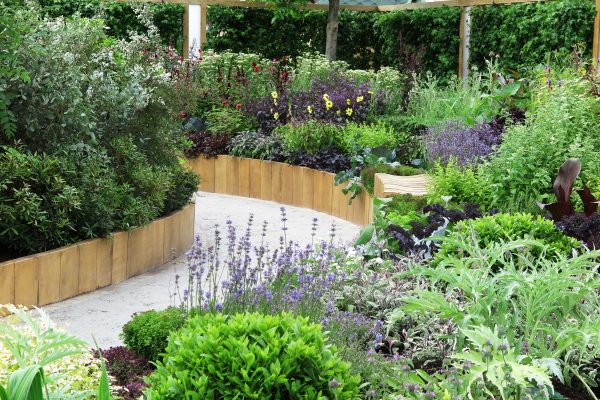
A rather smart white gravel path in an RHS Hampton Court Show garden. Friends who have had very smart white gravel report that you do have to spend alot of time picking leaves off it, and other maintenance issues.
A garden path that works with your environment
It’s also worth thinking about the wider environment when choosing a garden path. I don’t think we would have disliked the ugly red brick path so much if we’d seen it in a town context with red brick buildings. It struck a wrong note because it was in an otherwise very country-style garden.

Anna’s front garden, seen from the front door. Although it’s a town garden, it also overlooks the pebbly beach, which makes gravel a very harmonious choice.

And in a row of terraced yellow London brick Victorian houses, Posy Gentles has used the same kind of brick for her front path (it looks grey because dirt is always being trodden into it. But it essentially matches the house.)

A gravel path in the Rock Garden at Doddington Place Gardens. Gravel and rock go well together.
S shaped paths
The general rule, when creating a garden path, is to follow a straight line between two places. Otherwise you risk bald patches in the lawn, as people take short cuts across your garden.
However, the S shaped path is an important design tool, especially for long, thin town gardens.

This gentle S curve in Mel and Emma’s long, thin town garden adds shape and interest to the garden, but isn’t curved enough to encourage short cuts. Read more about Mel and Emma’s delightful garden here.

Posy has a path with a short curve in her back garden. It ends in a small patch of lawn. It means she has one big abundant bed on one side, which makes the garden feel less long and thin.
Garden path edges
I’ve seen some beautifully simple garden path edging. My absolute favourite is at Rosemary Alexander’s Sandhill home.

This fern edging at Rosemary Alexander’s Sandhill is simple but dramatic. Sandhill is open to visit several days a year.

Lavender is a classic choice for edging a path. My neighbour’s path is much admired.
If you have more than one path…
If you have more than one garden path, think about whether you want them to be different or to match. The garden we disliked (at the beginning of this post) had a number of different ugly paths – some were cheap concrete pavers and others were harsh red brick.
In contrast, the Salutation in Sandwich is a garden of a similar size. Its garden paths are harmonious.

The Salutation uses the same attractive brick for several paths throughout the garden. Read more about The Salutation here.
I have to admit that our own garden paths are a mix of gravel, stone, and even concrete pavers. But then you will notice that I am not featuring them in this post! Except the front garden, and (below) the mistake I think I made with the grouting.

This path in my garden is Indian sandstone (cheaper than York stone etc). After nine years, the grouting has finally started to look more natural, and it looks much better than it did.
I’d certainly advise you to think about the grouting if you’re using brick or stone pavers. I thoughtlessly decided on concrete grouting for our stone paving because I thought it would be nice not to weed it. I have since regretted it – a more natural sand grouting would have looked better, I think.
So am I being very unfair in criticising a fellow gardener for their choice of garden path? What do you think?
The post How important is your garden path? appeared first on The Middle-Sized Garden.
from The Middle-Sized Garden http://www.themiddlesizedgarden.co.uk/how-important-is-your-garden-path/
Friday, 28 July 2017
Woman fears her house will collapse if plans to build student flats in Reading go ahead
from getreading - Property http://www.getreading.co.uk/news/property/woman-fears-house-collapse-plans-13387170
Thursday, 27 July 2017
There are two surnames Prince George could have when he starts school
from getreading - Reading & Berkshire News http://www.getreading.co.uk/news/reading-berkshire-news/two-surnames-prince-george-could-13394236
Wednesday, 26 July 2017
Families wanted to bare all for new TV documentary
from getreading - Local News http://www.getreading.co.uk/news/local-news/families-wanted-bare-new-tv-13387775
Berkshire is officially the best county in the country for going to visit and giving you the warmest welcome
from getreading - What's On News http://www.getreading.co.uk/whats-on/whats-on-news/berkshire-officially-best-county-country-13381186
Tuesday, 25 July 2017
Reading second worst area in country for free school meal uptake
from getreading - Reading & Berkshire News http://www.getreading.co.uk/news/reading-berkshire-news/reading-second-worst-area-country-13380988
How you could get paid just for having an opinion online
from getreading - UK & World News http://www.getreading.co.uk/news/uk-world-news/how-you-could-paid-just-13384827
Tesco now has same day delivery in Reading and Berkshire
from getreading - Shopping http://www.getreading.co.uk/whats-on/shopping/tesco-now-same-day-delivery-13376368
Sunday, 23 July 2017
Which hedge is right for my garden?
A friend recently asked me which hedge she should choose for her garden.
It’s a bit like being asked for the answer to world peace. It’s rather a big question.

Garden maker Posy Gentles uses a clipped low privet hedge in her front garden as a foil to the airy plants that float over the top.
The first step is to ask another question: What do you want your hedge for? To mark a boundary? Encourage wildlife? Are you looking for a hedge for privacy? And is there a ‘fashion in hedges’?

I cut elderberries, rosehips, hazel and wild currants from a mixed hedgerow near me. You can see a ‘meadow’ strip of grass and wildflowers at the base of the hedge just behind the basket.
Which hedge is in fashion now?
The biggest new trend in hedging is probably the increased popularity of mixed native hedging.
Morris Hankinson of Hope Grove Nurseries says that their mixed packs of native hedgerow mixes with themes are ‘our best-sellers’. They sell edible hedging or ‘hedges for foragers’, coastal hedging, ‘hedging for privacy’, ‘hedging for wildlife’ packs and more.

You can plant these ‘edible hedge plants’ as a mix or a single hedge.
I’m delighted by the idea of edible hedging or a ‘hedge for foragers’, made of hazel, blackthorn (sloe), dog rose (rose hips), wild pear, elder and crab apple.
The eradication of mixed hedges or hedgerows in the last 100 years has been a major issue in the loss of habitat for wildlife. Now environmentally-aware farmers are replacing mixed hedgerows where they can, but we can also push for them to be grown in parks, public spaces and private gardens.

Frances Beaumont’s narrow town garden (around 20′ x 50′) has won several wildlife-friendly awards. She has mixed hedging along both sides of the garden. Plants include passionflower, honeysuckle, quince, apples, blackberries and ivy.
A mixed wildlife or foragers’ hedge, if it is allowed to flower and fruit, will spread more than a tightly clipped hedge. Although, as you can see from Frances’ hedge above, you can train it not to take up too much space.
But, alternatively, why not consider having a sprawling, colourful hedge, with a strip of wildlife ‘meadow’ below rather than a traditional border?
How to decide which hedge is right for your garden
People ‘overthink their hedge choice’, says Morris. ‘There are only two things you really need to bear in mind.
If you’re planting a hedge in a shady spot, you need hedging that copes with shade. And if it’s a damp area, you need hedging that can cope with that. Apart from that, it’s all quite simple.’
In which case I suggest that you decide what you want to achieve with your hedge first. Here are some hedge ideas to inspire you.
Divide the space up with a hedge

This rather grand treatment at Doddington Place Gardens would also work in smaller gardens. Doddington Place Gardens, near Faversham, Kent, is open to the public in the summer.
If you want to break your garden up into ‘rooms’ or areas, hedging is a good option. This hedge with steps would work well in a long narrow town garden, especially one with a slight slope. You could terrace it. Box, yew and privet are the traditional hedges for this sort of treatment. Photinia can also be trimmed in shape.
Which hedge as a backdrop for garden colour?
If you want your hedge as a backdrop for garden colour, then you might want to choose a single species in a fairly plain green. These include box, privet, yew and griselinia, all of which make a good backdrop for flower colour.

Dark green yew makes a wonderful contrast for these flowers at Doddington Place Gardens

A waist-high griselinia hedge makes a backdrop for red and orange dahlias and ricinus at The Salutation Gardens in Sandwich. If the hedge wasn’t there, the border would feel less lush.
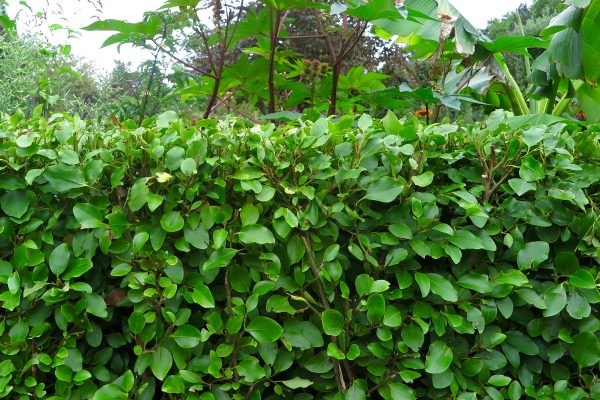
The other side of the griselinia hedge at The Salutation. It gives a neat edging to a path.
Other smart backdrops include beech, hornbeam and even cypress Leylandii, provided you keep it firmly trimmed.
Hedging as a punctuation point
Just as plain full stops and commas break up a sentence, gardens need their punctuation points too. Wonderfully lavish borders need a little geometry to give them structure.

Square boxes of box hedge anchor the airy, colourful planting in the Sunk Garden at Doddington Place.
Create shelter with a hedge
Hedges protect your garden from the wind better than fences do, because the wind is broken up by the hedging. With a fence or wall, the wind whistles over the top and can land on the other side with some force.
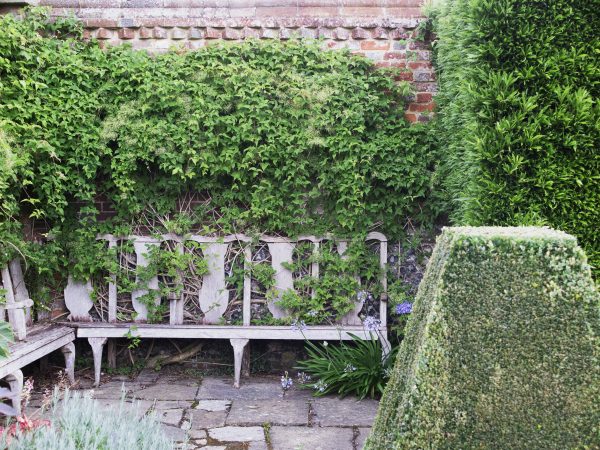
A hedge planted at right angles turns a wall into a sheltered corner at Doddington Place.

The veg garden at Rosemary Alexander’s Sandhill is sheltered from the beautiful landscape beyond with a hedge. This garden is open for the NGS (see website for dates)
You could easily use a mixed hedge here – an edible hedge might be perfect for a veg patch.
Do something different with hedging
If you’ve got plenty of space and about a hundred years to spare, you could do something like this with hedging. You could probably adapt this idea with a faster-growing hedging than yew – it would probably work with privet, for example.
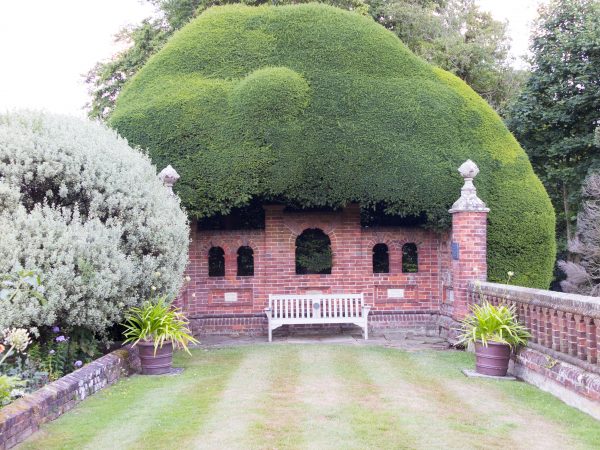
A seat by the pet cemetery at Doddington Place has a hedge ‘hat’.
Hedging as sculpture
You can frame a sculpture or a work of art with hedging.

A glass mirror garden sculpture at Doddington Place Gardens, framed by box hedging.
Hedging as contrast
Smart tailored hedging makes a good contrast to wilder plantings, such as meadow strips.
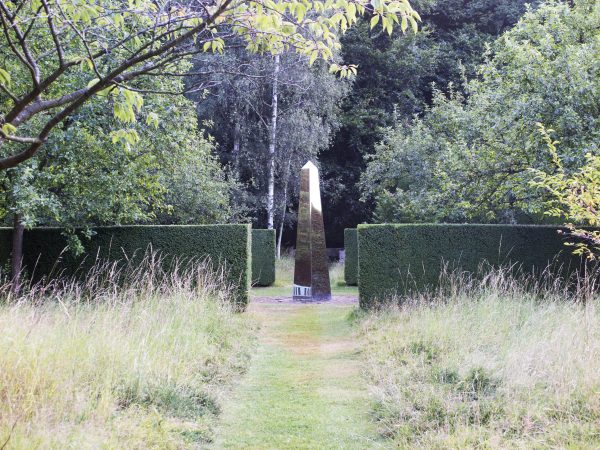
The linear formality of the hedges and mirror sculpture is contrasted with an informal meadow planting and simple mown path.

Pettifers is an outstanding garden of one and a half acres in Oxfordshire. It’s open to view by appointment. Here formal hedging creates contrast within a meadow area of the garden.
Equally, you could use a wonderfully rambling and colourful mixed hedge as a contrast to a smart lawn.
Hedges for wildlife
Wildlife need hedges both for shelter and food. An edible hedge will suit them very well, and mixed hedges offer the best range. Plants for a wildlife hedge include ivy, dog rose, blackthorn, elder, wild plum and hazel. If you want to know more about hedges for wildlife, see here.

Another stretch of Frances Beaumont’s ‘wildlife hedge.’ This is variegated elder – planted alongside ivy and honeysuckle (not shown).
Hedges for privacy
If you are thinking about hedges for privacy, be aware that a hedge is defined as ‘three trees in a row.’ Depending on whether there are any special rules and covenants where you live, you can often grow a hedge higher than a fence. Evergreen hedges offer more privacy, but less light. Deciduous hedges aren’t covered by legislation – or not in Britain, anyway.

Posy’s hedge is theoretically low for a privacy hedge, but the flowers dancing above it shield the windows from the eyes of passersby without affecting the light.
There’s more about planting evergreen hedges for privacy here. It specifically applies to Britain, but if you live elsewhere, it’ll give you an idea of what you need to check out before planting a hedge for privacy.
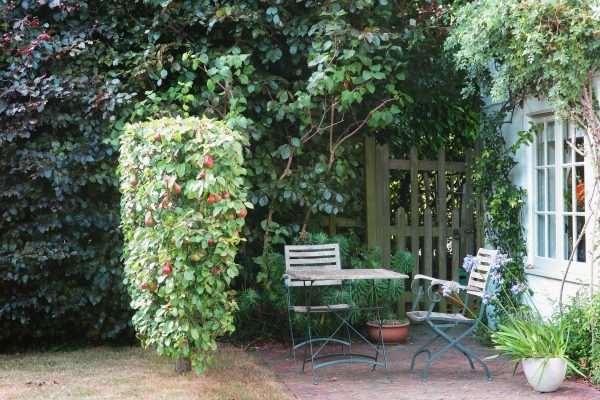
Pippa and James Rubinstein have screened a window and created a private seating area with a small, free-standing hedge of espaliered pear, clipped to remain only 5 feet high.
It may also be worth considering making your garden more private by placing just a single tree in the right place. There are 8 perfect-for-privacy trees here.
Hedges against pollution
A major international study lead by the University of Surrey recently concluded that hedging – even low hedges – is an excellent way of trapping particles of pollution and helping to keep the air near them clear.

This hedge helps protect the houses from car exhaust pollution. The trees and the hedges absorb carbon dioxide and release oxygen. The RHS is trying to encourage us all to plant some hedging in our front gardens and drives as part of their Greening Grey Britain campaign.
So far, no specific hedge plants have been suggested as better than any other for anti-pollution, so choose the hedge you like the best for other reasons.
Warning! Plant your hedge right – or else!
How you plant your hedge makes a huge difference to whether it grows well. The two pictures below show two yew hedges planted near a friend’s house. The yews came from the same nursery and were planted on the same day by the same people.

My friend’s yew hedge. This one was planted properly.
But one was planted into a ready-prepared trench with lots of compost and then well watered. The other – possibly because time was running out – was simply dug into the ground.

The same hedging plants in the same garden, planted on the same day – but without properly prepared soil and compost! Both hedges are now several years old, so poor planting has long-term effects.
You can download a guide to choosing, planting and looking after your hedge here:Hedging Guide from Hopes Grove Nurseries
And for ‘How to Plant A Hedge’ on YouTube, see here:
And look after your hedge in the first year
Hedges are reasonably low maintenance. Fences often need painting, repairing or replacing, but a hedge will go on forever with just an annual clip.
However, the first year is important, Morris says. This reflects what every other plant expert and nurseryman has ever told me. Trees and shrubs need looking after in their first year.
So you need to water and weed around your new hedging plants regularly in that crucial first summer.
So which hedge really is right for my garden?
Now that you have considered all the factors that matter, it’s time to talk to a hedge supplier. I don’t advise that you get your hedging from all-purpose garden centres, because every garden is different. It will really help to talk to someone knowledgeable, even on the phone.
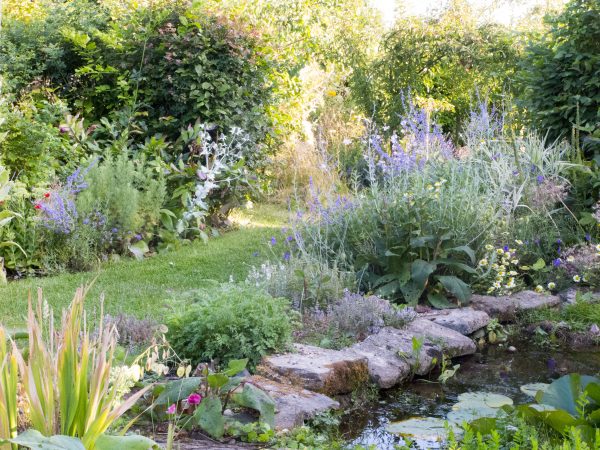
Kylie O’Brien’s one acre country garden (open by appointment via the NGS) overlooks fields, so her hedges act as windbreaks. So she chose hardy native plants, such as hazel, dog rose and field maple.
Once you’ve thought about what you want your hedge to do for your garden, you’ll probably have a shortlist of hedging possibilities. You’ll find a better range from a hedging supplier, and there’ll be experts who can confirm your choice will grow well in your garden.
The question of ‘which hedge’ is also about whether to buy cheaper, younger hedging or spend significantly more for an immediate impact.

This hedge of field maple, dog rose, elder, wild currant and hazel is now five years old, having been planted as ‘young whips’. It’s been looking like a ‘proper hedge’ for around two years.
Specialist plant/hedging nurseries will probably also be cheaper than garden centres. Bare root hedging, which can only be planted between November and March, often costs less than £1 a plant. But it takes 2-3 years – or more – before it will be the hedge of your dreams.
‘Instant hedging’ will cost at least ten times as much (literally!), but will look great immediately.
Writing this post has opened my eyes to the beauty of a good hedge. Instead of seeing a hedge as a mass of green, I now take pleasure in spotting dog rose, hazel, elderberries, sloes and more. Hedges are good for wildlife, and also good for the environment, and they are a good foil for the planting in your garden.
I’ve also started looking at gardens for their hedges, rather than their flowers. It’s an interesting new perspective, especially in terms of photography. Do give it a try!
Pin this for later:
The post Which hedge is right for my garden? appeared first on The Middle-Sized Garden.
from The Middle-Sized Garden http://www.themiddlesizedgarden.co.uk/which-hedge-is-right-for-my-garden/
Friday, 21 July 2017
Huge inflatable aqua park in Reading to become even bigger
from getreading - Family & Kids http://www.getreading.co.uk/whats-on/family-kids-news/huge-inflatable-aqua-park-reading-13365019
Wednesday, 19 July 2017
Berkshire star Chris Evans is highest paid BBC employee
from getreading - Reading & Berkshire News http://www.getreading.co.uk/news/reading-berkshire-news/berkshire-star-chris-evans-highest-13353393
Secondary school in Earley closed due to flash flooding
from getreading - Reading & Berkshire News http://www.getreading.co.uk/news/reading-berkshire-news/secondary-school-earley-closed-due-13352214
Monday, 17 July 2017
Berkshire revealed as one of the UK's creative hotspots
from getreading - Business http://www.getreading.co.uk/news/business/berkshire-revealed-one-uks-creative-13343334
The 14 Fringe Festival acts that were made in Reading
from getreading - Arts & Culture http://www.getreading.co.uk/whats-on/arts-culture-news/14-fringe-festival-acts-were-13343378
Driver jailed after deliberately running man over
from getreading - Reading & Berkshire News http://www.getreading.co.uk/news/reading-berkshire-news/driver-jailed-after-deliberately-running-13341560
Sunday, 16 July 2017
How to turn a pergola into a simple gazebo.
We decided to turn a neglected pergola in the corner of the garden into a simple gazebo, in order to create an ‘outside room.’
It has a wonderful view of the garden.

The view from the pergola along the back border. Sadly, the view of the pergola was less attractive.
But it was at the other side of the garden, so we had to take cushions, books, etc out there every time we used it. As a pergola doesn’t have a weatherproof roof, we couldn’t leave much out there.

If you look at the far corner of this picture, you can just see the pergola. It’s not far to take cushions and books, but it’s easy to forget to take them back, and if it rains…
It meant we hardly ever sat there. So we wanted all-weather ‘outside room’. Without spending much money.
I fell in love with corrugated iron sheds when we were in Australia. My brother-in-law, Richard, has just moved there,. He was told that ‘you can’t consider yourself an Australian man until you can work with corrugated iron.’

Inspiration from Australia – horticulturalist and TV presenter Stephen Ryan’s beautifully simple woodshed with wooden sides and a corrugated iron roof.
So he offered to add a corrugated iron roof to our pergola to turn it into a gazebo (a gazebo is a pergola with a roof. It can be a tent or permanent).
Can you use the original pergola?
Richard decided to use the original pergola as a structure for the gazebo. There were struts across the roof, sticking out. He removed these and reworked them into a simple rectangular frame, to which the corrugated iron could be screwed.
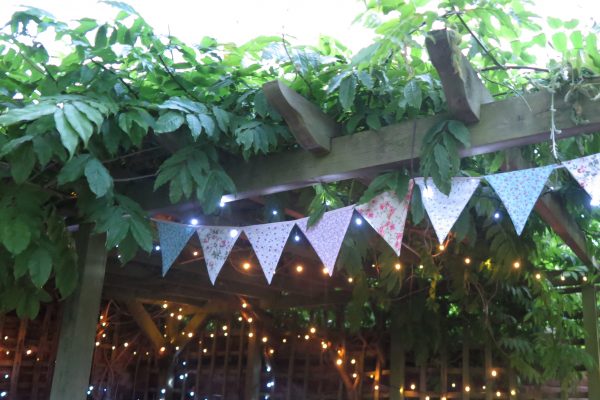
See the struts sticking out? It would be difficult to attach corrugated iron evenly to them.
However, that will depend on what condition the wood is in. Although our pergola is probably more than 20 years old (it was here when we bought the house), it’s made of cedar, so is long-lasting (and nicely weathered). Richard thought it was worth re-using.

Instead of struts across, there is now a square frame for the corrugated iron to sit on.
Now for the corrugated iron roof
I’d originally thought of buying recycled corrugated iron, but couldn’t find any I liked. And when I photographed garden maker Posy Gentles’ shed, she’d used a curved new corrugated iron for the roof. It almost disappears, as you can see from the photograph below.

Posy Gentles’ homemade shed has a curved corrugated iron roof. So we decided on curved corrugated iron.
We ordered it from Southern Sheeting. You need to measure the width and length of the roof, and how high you want it to be. Don’t forget to take any overhang into account. They delivered 5 sheets cut to order. We gave them 2-3 weeks notice.
The next stage
Richard then added a central beam to support the roof, at the top of the curve. He bought a strong new piece of wood for this.

Richard set the new roof support on top of T shaped stubs made of the old wood. The wires you can see are solar fairy lights. A friend has pointed out that ‘lights need to look good in the daytime as well as when they’re lit’ so I have a little more styling to do in here.

Richard adding the five sheets of curved corrugated iron to the new roof structure. He said that it was harder to work on curved corrugated iron than straight.
The important thing is getting the first piece of corrugated iron aligned. Corrugated iron fits by overlapping one and a half corrugations, so each piece rests on the previous piece.
He used self-tapping screws with an electric screwdriver, which means that he didn’t have to drill holes for them.
How long did it take?
The work took Richard 2-3 days to complete. If you’d worked in curved corrugated iron before, it might have taken a little less time.

We enjoyed a candlelit BBQ in the new gazebo. We’re still not sure what to call it. I favour The Tin Corner. A friend tells me that Gertrude Jekyll (or possibly someone else) created a gazebo with just four columns and a roof, so that she could sit there and listen to the rain. It was called The Rain House.
The cost
The curved sheeting for the roof cost around £300. If you were costing labour, too, you’d need to add the 2-3 days work (thank you, Richard!).
Screws, brackets and the new wood cost around £60. Richard used a circular saw to cut the wood, as well as the electric screwdriver. The corrugated iron screws came with the corrugated iron, so you order those from the supplier.

And the new Tin Corner by daylight.

And we can have breakfast in the garden.
How easy is it?
Richard describes himself as ‘handy’ rather than an ‘expert DIYer’, having built a corrugated iron structure in Australia. He learned how to work with corrugated iron from YouTube.
The end result….
We’ve eaten outside every night since. It has rained – extensively – and our cushions stayed dry. However, it’s worth noting that we haven’t put guttering on. Where the rain falls on the soil, it’s absorbed. However, on one side of the gazebo, the rain falls on the stone floor. That splashes quite a bit, so that side does get a bit wet.

Vintage folding chairs for seating.
So I’d advise making sure that the overhang on both sides goes onto earth, rather than splashing onto stone. I’ve noticed that restaurants edge their pavement seating areas with pots and troughs – I wonder if this is to absorb water dripping from canopies rather than splashing their customers? I plan some pots and troughs…more styling ahead…
Pin this for later
The post How to turn a pergola into a simple gazebo. appeared first on The Middle-Sized Garden.
from The Middle-Sized Garden http://www.themiddlesizedgarden.co.uk/turn-pergola-simple-gazebo/


